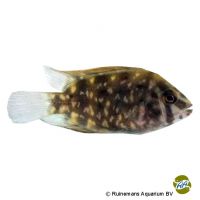Panda Uaru (Uaru fernandezyepezi)
| Panda Uaru Uaru fernandezyepezi | |
|---|---|
| Name | Panda Uaru |
| Name Lat. | Uaru fernandezyepezi |
| Family | Cichlids |
| Family lat. | Cichlidae |
| Order | Cichlids |
| Order lat. | Cichliformes |
| Origin | Venezuela |
| Habitat | Rivers, oxbow lakes |
| Diet | Omnivore |
| pH | 6.0-7.0 |
| Behavior | Peaceful |
| Keeping | Pair, group |
| Care Level | Difficult |
| Reproduction | Substrate spawner |
| Breeding | Difficult |
| Life Span | 8-12 years |
| Protection | No |
| Metric Units | |
| Size | 25 cm |
| Temperature | 27-30 °C |
| Hardness | 1-5 °dH |
| Aquarium | ~ 500 l |
| US Units | |
| Size | 10" |
| Temperature | 81-86 °F |
| Hardness | 18-89 ppm |
| Aquarium | ~ 130 gal |
Distribution and habitat
The range of the Venezuelan Uaru is the river system of the Rio Atabapo, a tributary of the Orinoco in Venezuela. They live in sluggish flowing or stagnant waters, where they often stay in groups in deep water, among roots, dead wood and stones.
Maintenance
The aquarium should have some robust plants for decoration, with many hiding places (stones, roots), and offer free swimming space. A substrate covered with some foliage (e.g. sea almond leaves), strongly dimmed light and very soft, slightly acidic water is ideal
No ammonia, ammonium and nitrite should be detectable, the nitrate value should not exceed 100 mg/l. To ensure the water quality and oxygen content, a filter and heater adapted to the aquarium size is required, as well as lighting for the species-appropriate day-night rhythm of the animals.
Diet
The food supply consists of high-quality dry food for cichlids (pellets, granules), supplemented with live or frozen food, such as artemia, mysis, shrimps and red mosquito larvae or a commercially available, frozen special food mix for cichlids. Furthermore, they need sufficient vegetable food, such as spinach, crushed peas, duckweed, algae leaves or dry food with high vegetable content (spirulina) as well as soft bogwood.
Only feed as much as will be eaten within a few minutes. A regular and varied diet promotes health and increases resistance.
Behaviour and compatibility
They are calm peaceful fish, which show a pronounced territorial behavior only during the spawning season. It is recommended to keep them in pairs or in a group. Keeping a group is only recommended in a much larger, richly structured tank. They can be well socialized with other calm, peaceful and heat-loving fish, such as Tetras, Angelfish, etc
Basically, only compatible fish species with similar demands on water condition and water temperature should be socialized.
Sex dimorphism
Outside the spawning season the sexes are hardly distinguishable. With some experience, the sexes can be determined during mating by the shape of the genital papilla, which is pointed in the male and round in the female.
Reproduction and breeding
After a pair is found, the female usually spawns on a flat stone or root (open brooder). Both parents perform brood care and intensively defend the territory (parental family). After 2-3 days, the fry hatch and are then housed and guarded in a prepared bottom pit until they swim freely after 5-7 days. The parents produce a skin secretion that serves as additional food for the fry. The fry continue to be led around the aquarium and cared for for some time before brood care ends
Fry must be fed several times a day with special rearing food (e.g. Artemia nauplii). In community tanks breeding is hardly possible, because the fry are easy prey.
Important
They are very sensitive to changes in water quality, so pay special attention to water values.
Plants are considered food, accordingly only hard-leaved, robust plants are suitable for decoration, secured with stones against burrowing.
The well-being of the fish should be checked regularly. The temperature should be checked daily, the pH value, hardness and nitrate value at least every 14 days. Regular partial water changes are recommended, even if the contaminant level has not yet reached the upper limit. Sudden changes in water quality should be avoided. Newly introduced fish must be accustomed slowly to the water in the aquarium.
Further literature can be found in your pet store.
References
Text: petdata; Image: Ruinemans Aquarium B.V.
Source: BMEL (1998): Tierschutzgutachten - Haltung von Zierfischen (Süßwasser); ENGELMANN (2005): Zootierhaltung - Tiere in menschlicher Obhut: Fische, Verlag Harri Deutsch
- Gemäß § 21 Abs. 5 Tierschutzgesetz idgF
